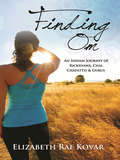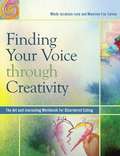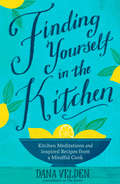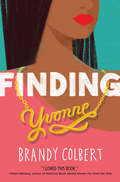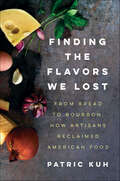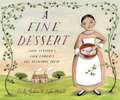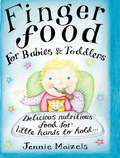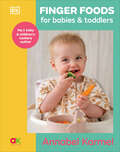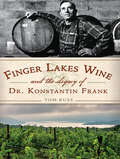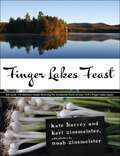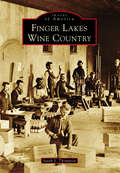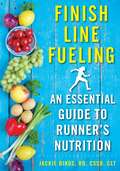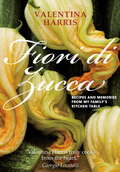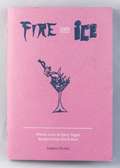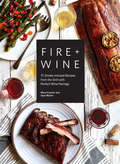- Table View
- List View
Finding My Voice: Nadiya's honest, unforgettable memoir
by Nadiya Hussain'A fascinating from-the-heart memoir' Nigel Slater'A revelatory honest read' Red magazineFUNNY, HEART-WRENCHING, GENEROUS AND TRUE, IN FINDING MY VOICE NADIYA HUSSAIN SHARES THE UNFORGETTABLE MEMORIES AND EXPERIENCES THAT HAVE MADE HER THE WOMAN SHE IS TODAY.'I am writing this for everyone who was told no. 'No, you are not rich enough. No, that is not credible. No, you can't. No, you won't. No, you are not allowed. No, that is not appropriate. I was told, "No, you do not belong." Finally, I am saying, "Yes, I do."'From the moment Nadiya Hussain was born, she has been questioning her role in life. But the irony is, she never wanted to be a trailblazer. She just wanted to follow a 'normal' path. But life kept telling her 'you can't'. And so she found her own way, beyond anything she dared to dream . . .In this wise, witty, open-hearted book, Nadiya lets us into her life and, for the first time, shares the memories and experiences that have shaped her into the woman and role-model that she is today, alongside her personal recipes and the stories they tell. 'We all have a voice. Yours might be loud and strong, or quiet yet insistent. I have always tried to use mine for the right reasons.'
Finding My Voice: Nadiya's honest, unforgettable memoir
by Nadiya Hussain'A fascinating from-the-heart memoir' Nigel Slater'A revelatory honest read' Red magazineFUNNY, HEART-WRENCHING, GENEROUS AND TRUE, IN FINDING MY VOICE NADIYA HUSSAIN SHARES THE UNFORGETTABLE MEMORIES AND EXPERIENCES THAT HAVE MADE HER THE WOMAN SHE IS TODAY.'I am writing this for everyone who was told no. 'No, you are not rich enough. No, that is not credible. No, you can't. No, you won't. No, you are not allowed. No, that is not appropriate. I was told, "No, you do not belong." Finally, I am saying, "Yes, I do."'From the moment Nadiya Hussain was born, she has been questioning her role in life. But the irony is, she never wanted to be a trailblazer. She just wanted to follow a 'normal' path. But life kept telling her 'you can't'. And so she found her own way, beyond anything she dared to dream . . .In this wise, witty, open-hearted book, Nadiya lets us into her life and, for the first time, shares the memories and experiences that have shaped her into the woman and role-model that she is today, alongside her personal recipes and the stories they tell. 'We all have a voice. Yours might be loud and strong, or quiet yet insistent. I have always tried to use mine for the right reasons.'
Finding Om: An Indian Journey of Rickshaws, Chai, Chapattis & Gurus
by Elizabeth Rae KovarFinding Om is a travel memoir that looks into the mind and soul of 22-year old, Bowling Green State University college student, Elizabeth. In 2005, Elizabeth studied abroad in Australia, which ignited a fresh perspective on life. Australia, and the ocean, became her first love - a sacred place that rebirthed her soul and introduced her to yoga. Emboldened by the South Pacific, Elizabeth returned to Ohio and fell ill from reverse culture shock. Her collegiate responsibilities, boyfriend issues and negative perspectives about Ohio spiraled out of control. Anxiety, stress, insomnia and panic attacks ruled her life. Stress triggered an unbalanced life, filled with addictions and mental despair, which disconnected Elizabeth from her soul. Elizabeth desired change and the need to re-identify herself with the world. She needed to find a way to travel abroad. Recipient of BGSU's inaugural, Stuart R. Givens Fellowship, a grant to fund a student to "do anything in the world," Elizabeth proposed to backpack and to study yoga in the world's most hectic country, India, solo. In the summer 2007, Elizabeth left the US with three thousand dollars, one red backpack and a bagful of questions in search of enlightenment, acceptance and inner peace. Finding Om is a spiritual, and chaotic, journey through the highs and lows of India. Vivid and suspenseful, these are the tales of palm reader prophecies, the romances with a soul mate, the troubles of tour guide scams, the teachings from yoga gurus and the illuminating conversations had over a cup of chai. This is an intimate and true story of an intrepid young female on a quest to find compassion, adventure and a home in the world.
Finding Peace with Your Body: A Body Image Guide for Women
by Johanna KulpFinding Peace with Your Body weaves together the author’s personal story as well as her work as a psychotherapist to create an interactive self-help guidebook to help readers find harmony with their bodies. This is an interactive book with a fresh perspective that encourages the reader to dive deeper into their own personal history and use this book as a place to journal and complete specific homework instructions to change their relationship with their body. This book includes personal anecdotes, theoretical orientation and specific clinical intervention in a way that helps the reader understand context, personal experience and the ability to create direct behavioral and cognitive change in their life. The journey map includes not only reflective prompts but also weaves in historical context regarding the subjugation of women’s bodies throughout time. Organized so that it can be used by individuals or practitioners assisting their clients along the journey of recovery from an eating disorder, this book offers readers hope, practical tools and a road map for working through specific body image issues with practical skills and therapeutic interventions.
Finding Tasty Foods in Unlikely Places (Fountas & Pinnell LLI Purple #Level R)
by Terry ShannonLuxury food from poop, spit, and dirt. Describes unusual foods from around the world, from bird's nest soup to truffle treasure.
Finding Turtle Farm: My Twenty-Acre Adventure in Community-Supported Agriculture
by Angela TedescoThe story of starting and running an organic farm—told by the woman who owned one of the first Community-Supported Agriculture operations in the Upper Midwest On a twenty-acre farm in Iowa in 1995, Angela Tedesco planted the seeds (quite literally) of a quiet revolution. While American agriculture had strayed so far afield, her farm would raise food that served the earth and the community as well as the palate. In Finding Turtle Farm, Tedesco recounts this adventure in all its down-and-dirty work and wonder, from plan and plot to harvest, with nods along the way to the vagaries of weather, pests, and human nature.Introducing Community-Supported Agriculture to Iowa, Tedesco&’s Turtle Farm educated its customers along with providing seasonal boxes of produce—an undertaking that continues here, as Tedesco describes what it takes to establish and run an organic operation, bringing to bear all her experience growing up on a family farm, studying chemistry and horticulture, and shepherding a religious education program. From ordering seeds and tending greenhouses to surviving floods and a personal health crisis, Tedesco tells a story of transforming a piece of land and the life within it. She includes practical information about harvesting and preserving food, the discoveries of research conducted on the farm and bonds established between farmers, and even recipes to make delicious use of the produce in your CSA box.Looking forward to a healthier, happier future when crops are more than mere commodities and food feeds the soul of a community, Finding Turtle Farm is an enlightening, hard-won, and ultimately hopeful account of what it means to meet the most basic of human needs.
Finding Your Fit: A Compassionate Trainer’s Guide to Making Fitness a Lifelong Habit
by Kathleen TrotterTen simple, practical ways to get moving, get healthy, and feel great. Wanting to get on track and actually getting (and then staying) on track are two totally different things. The million-dollar question is: how do we find the inner motivation to go from thinking about a healthier lifestyle to actually adopting one? How do we get off the sofa and out the front door? Finding Your Fit: A Compassionate Trainer’s Guide to Making Fitness a Lifelong Habit provides readers with practical tools that will allow them to connect the dots between wanting to make a health and fitness change, and actually making it.
Finding Your Passion: The Easy Guide to Your Dream Career
by Marcy MorrisonFinding Your Passion is a powerful, yet easy-to-use book by Marcy Morrison, Career Strategist and Owner of Careers With Wings (www.careerswithwings.com). This fun and whimsical book will help and guide the reader to develop wings for their career and get on the fast track to finding their dream job via identifying their passions and strengths; empowering them with tools to market and sell themselves; strengthening their ability to trust their gut/believe in themselves; learning how to network; developing a support team; enhancing their current job; and creating a personalized plan for success.
Finding Your Voice Through Creativity
by Mindy Jacobson-Levy Maureen Foy-TornayThis workbook combines art therapy exercises and guided journal writing for individuals who want to explore their relationship with food and their bodies in a new way. Written by board-certified art psychotherapists, the pages of this workbook literally serve as a canvas for thoughts and feelings "spoken" primarily through art and elaborated upon through writing. Readers are encouraged to draw, write, and create directly in the book. These images, symbols, and journal entries then become a "personal signature" that can be accessed and explored to resolve any obstacles to emotional well-being. Included are 58 expressive art projects and corresponding written exercises, which lead readers through specific stages of self-discovery related to disordered eating patterns, body image issues, relationships, life skills, emotions, self love, and personal transformation.
Finding Yourself in the Kitchen: Kitchen Meditations and Inspired Recipes from a Mindful Cook
by Dana VeldenMany books teach the mechanics of cooking and even inspire us to cook; not many dwell on the kitchen's ability to be a place of awakening and joy. In Finding Yourself in the Kitchen, Dana Velden asks you to seek deeper meaning in this space and explores what cooking can teach about intimacy, failure, curiosity, and beauty. Finding Yourself in the Kitchen is a book of essays, each focused on a cooking theme that explores how to practice mindfulness in the kitchen--and beyond--to discover a more deeply experienced life. It also offers meditation techniques and practical kitchen tips, including 15 of Velden's own favorite recipes. What happens when we find ourselves in the kitchen? What vitalizes, challenges, and delights us there? An extension of her popular "Weekend Meditation" column on TheKitchn.com, this book offers you the chance to step back and examine your life in a more inspired way. The result is a reading experience that satisfies, nourishes and inspires.
Finding Yvonne
by Brandy ColbertFor fans of Nicola Yoon and Nina LaCour comes a striking novel about difficult choices from acclaimed author Brandy Colbert.Since she was seven years old, Yvonne has had her trusted violin to keep her company, especially in those lonely days after her mother walked out on their family. But with graduation just around the corner, she is forced to face the hard truth that she just might not be good enough to attend a conservatory after high school.Full of doubt about her future, and increasingly frustrated by her strained relationship with her successful but emotionally closed-off father, Yvonne meets a street musician and fellow violinist who understands her struggle. He's mysterious, charming, and different from Warren, the familiar and reliable boy who has her heart. But when Yvonne becomes unexpectedly pregnant, she has to make the most difficult decision yet about her future.From the author of Pointe and Little & Lion, comes another heartfelt novel about the twists and turns that can show up on a path meant only for you.
Finding the Flavors We Lost: From Bread to Bourbon, How Artisans Reclaimed American Food
by Patric KuhThe multiple-James Beard Award–winning restaurant critic for Los Angeles Magazine delivers an arresting exploration of our cultural demand for “artisanal” foods in a world dominated by corporate agribusiness.We hear the word “artisanal” all the time—attached to cheese, chocolate, coffee, even fast-food chain sandwiches—but what does it actually mean? We take “farm to table” and “handcrafted food” for granted now but how did we get here? In Finding the Flavors We Lost, acclaimed food writer Patric Kuh profiles major figures in the so-called “artisanal” food movement who brought exceptional taste back to food and inspired chefs and restaurateurs to redefine and rethink the way we eat.Kuh begins by narrating the entertaining stories of countercultural “radicals” who taught themselves the forgotten crafts of bread, cheese, and beer-making in reaction to the ever-present marketing of bland, mass-produced food, and how these people became the inspiration for today’s crop of young chefs and artisans. Finding the Flavors We Lost also analyzes how population growth, speedier transportation, and the societal shifts and economic progress of the twentieth century led to the rise of supermarkets and giant food corporations, which encouraged the general desire to swap effort and quality for convenience and quantity.Kuh examines how a rediscovery of the value of craft and individual effort has fueled today’s popularity and appreciation for artisanal food and the transformations this has effected on both the restaurant menu and the dinner table. Throughout the book, he raises a host of critical questions. How big of an operation is too big for a food company to still call themselves “artisanal”? Does the high cost of handcrafted goods unintentionally make them unaffordable for many Americans? Does technological progress have to quash flavor? Eye-opening, informative, and entertaining, Finding the Flavors We Lost is a fresh look into the culture of artisan food as we know it today—and what its future may be.
Fine Dessert: Four Centuries, Four Families, One Delicious Treat
by Emily Jenkins Sophie BlackallIn this fascinating picture book, four families, in four different cities, over four centuries, make the same delicious dessert: blackberry fool. This richly detailed book ingeniously shows how food, technology, and even families have changed throughout American history. In 1710, a girl and her mother in Lyme, England, prepare a blackberry fool, picking wild blackberries and beating cream from their cow with a bundle of twigs. The same dessert is prepared by a slave girl and her mother in 1810 in Charleston, South Carolina; by a mother and daughter in 1910 in Boston; and finally by a boy and his father in present-day San Diego. Kids and parents alike will delight in discovering the differences in daily life over the course of four centuries. Includes a recipe for blackberry fool and notes from the author and illustrator about their research.
Finger Food For Babies And Toddlers: Delicious Nutritious Food For Little Hands To Hold
by Jennie MaizelsFinger Foods for Babies and Toddlers: From the No. 1 Children's Cookery Author
by Annabel KarmelWhat finger foods are best for my baby? How do I prepare them safely? What should I avoid? How do I move on from simple finger foods? How can I get my baby to eat veggies?From around 6 months, parents are encouraged to introduce soft finger foods into their baby’s diet - either alongside purées or as part of baby-led weaning. Finger foods are the ideal way to introduce babies to different textures, and by handing the reins to your baby, you will empower them to figure out how to get food to their mouth, break pieces off and chew, and have all-around fun with food! Yet many parents are naturally cautious about giving finger foods to their children for fear of choking. Equally, once parents have mastered simple finger foods, they often find it a challenge to think up interesting and nutritious ideas to fuel little ones.Annabel’s complete guide to raising independent eaters steers families through finger foods, helping to nurture a generation of food explorers! From first-taste broccoli florets to baked veggie tots…and carrot sticks to curried bites, this book is packed with essential advice, tips, visual guides, and delicious recipes.
Finger Lake Wine and the Legacy of Dr. Konstantin Frank (American Palate)
by Tom RussThe remarkable story of a refugee from Soviet Ukraine who found his way to upstate New York—and changed the American wine industry. Dr. Konstantin Frank forever changed the palate of American wine. Forced from his home in Soviet Ukraine during World War II, he was astounded by the terroir when he arrived in the Finger Lakes region, an agricultural scientist from a foreign land desperately looking for work. Against popular notions, he believed that the vinifera grapes that produced some of Europe&’s and California&’s finest wines would prosper in this part of New York State, but was met with skepticism and resistance. He proved his detractors wrong, and because he shared his knowledge freely with others, Konstantin&’s innovativeness has allowed the region to produce some of the world&’s finest Riesling, Chardonnay, Pinot Noir, and other varietals. Four generations of Franks have continued his legacy, and their winery has won record numbers of prestigious awards every year. This book tells the inspiring story. Includes photographs
Finger Lakes Feast: 110 Delicious Recipes from New York's Hotspot for Wholesome Local Foods
by Karl Zinsmeister Kate Harvey Noah ZinsmeisterThe Finger Lakes area of New York State is on the cutting edge of the regional food movement. It is home to award-winning restaurants, more than 100 wineries, and farms that produce organically grown vegetables, meats, and dairy products. This cookbook presents 110 amazing recipes that are delicious examples of how an area can produce food near where it is consumed. Many of the recipes are adaptations for family cooking of the finest creations by the area's best chefs. Featuring recipes such as the famous Dinosaur BBQ's sauce and the intriguing Tomato Pie, local flavor abounds in this niche and unique cookbook.
Finger Lakes Wine Country (Images of America)
by Sarah ThompsonFor more than 150 years, Finger Lakes Wine Country has played a major role in American wine history. At its heart are the four deepest Finger Lakes, part of a group of 11 long, narrow lakes in central New York. There, nestled among Canandaigua, Keuka, Seneca, and Cayuga Lakes, farmers began planting vineyards in the 1830s. In 1860, the Pleasant Valley Wine Company became America's first bonded winery, turning Keuka Lake into a busy shipping hub for fresh grapes and award-winning champagnes. Other wineries soon followed, as did railroads and basket factories. Early 20th century business was good until Prohibition forced wineries to reinvent themselves. In the 1950s and 1960s, innovators like Charles Fournier, Dr. Konstantin Frank, and Walter S. Taylor experimented with hybrid and European vinifera grape varieties. But by the 1970s, local grape growers faced extinction; it would take a grassroots movement and landmark legislation in 1976 to bring about a Finger Lakes wine renaissance.
Finish Line Fueling: An Essential Guide to Runner's Nutrition
by Jackie DikosDelicious recipes and essential nutrition tips for runners.
Fiori di Zucca
by Valentina HarrisValentina has a wonderful story to tell. Her grandfather, Count Carlo Sforza, who became the Italian Ambassador, was posted to Constantinople, Peking (at the end of Imperialist China), Corfu, Rome and Paris. In 1922 he resigned in order to return to Italy to fight facism. The family suffered brutal harassment, forcing him to flee - going back to Peking and on to the US - and the family to move to Brussels, then on to France, the UK, Canada and the US for most of WW2. Finally the family returned to Italy after the war. This is where Valentina's mother met her English husband - Valentina's father. Having caused a scandal with their marriage, her mother and father were banished to Tuscany, where Valentina spent most of her childhood. Against a backdrop of different cultures and cuisines, Valentina narrates beautiful and powerful stories - along with her discovery of pure, intense happiness from cooking. Gorgeous recipes guide you through Valentina's history.You'll find the Braised Cinnamon Duck with Caremelised Pears that Valentina's mother created in memory of their Russian ancestors and the Belgrade Almond Cake that Valentina used to eat with her cousins from Montenegro, as well as the Seafood Risotto that Beppino, their cook, taught her in Italy and the Nougat Semifreddo that she used to eat with her father on the via Veneto in Rome. Here are 85 recipes that have been handed down through the generations or inspired by family stories and experiences. This is the culmination of Valentina's career and the book of her heart and soul
Fiori di Zucca
by Valentina HarrisValentina has a wonderful story to tell. Her grandfather, Count Carlo Sforza, who became the Italian Ambassador, was posted to Constantinople, Peking (at the end of Imperialist China), Corfu, Rome and Paris. In 1922 he resigned in order to return to Italy to fight facism. The family suffered brutal harassment, forcing him to flee - going back to Peking and on to the US - and the family to move to Brussels, then on to France, the UK, Canada and the US for most of WW2. Finally the family returned to Italy after the war. This is where Valentina's mother met her English husband - Valentina's father. Having caused a scandal with their marriage, her mother and father were banished to Tuscany, where Valentina spent most of her childhood. Against a backdrop of different cultures and cuisines, Valentina narrates beautiful and powerful stories - along with her discovery of pure, intense happiness from cooking. Gorgeous recipes guide you through Valentina's history.You'll find the Braised Cinnamon Duck with Caremelised Pears that Valentina's mother created in memory of their Russian ancestors and the Belgrade Almond Cake that Valentina used to eat with her cousins from Montenegro, as well as the Seafood Risotto that Beppino, their cook, taught her in Italy and the Nougat Semifreddo that she used to eat with her father on the via Veneto in Rome. Here are 85 recipes that have been handed down through the generations or inspired by family stories and experiences. This is the culmination of Valentina's career and the book of her heart and soul
Fire & Ice (Vegan Cookbooks Ser.)
by Joshua PloegTraveling chef Joshua Ploeg (Plague) of Behead the Prophet, No Lord Shall Live/Mukilteo Fairies/Ravenna's Secret Cafe presents 80 new and delicious, gourmet vegan recipes. Joshua is the epitome of the post-punk ethic manifest into his passion; traveling the country on buses and trains he presents gourmet dinner parties for you and your friends presented out of his backpack, circumventing the corporate route of disseminating his food, recipes, and love. This collection in particular is primarily spicy recipes and beverages - blazing tofu, curried pineapple cream cheese, chicken yassa, garlic linguine, pineapple gazpacho with dates, blackeyed pea salsa, curried banana sandwiches, spicy basil turnip and tofu, iced tea with mango syrup, numerous alcoholic drink recipes, and much much more!
Fire & Smoke: Get Grilling with 120 Delicious Barbecue Recipes
by Rich Harris'Rich's recipes are exciting, accessible and fun. Everything a great barbecue should be' Heston BlumenthalRich Harris shows you how to barbecue mouthwatering recipes with smoky and succulent flavours that will see you through the summer and beyond in style. Featuring chapters on:* From the Sea - delicious fish and seafood dishes* Crowd-pleasers - food to impress friends, such as Beef Short Ribs and Sticky Pork Belly & Rice Noodle Salad* Hand-held - get messy with Chilli Dogs, Smoked Chicken Wings and Lamb Shish Kebabs* Smoking - including hot-smoked classics like Pulled Pork and Prawns with Dirty Romesco Sauce to Cold smoked Salmon* Veggies, Sides & Breads - barbecues aren't just about meat so indulge in Chargrilled Leaves with Burnt Lemon Dressing, Cauliflower Steaks and Chipotle Slaw* Sauces, Dips & Pickles - accompaniments to take your dishes to the next level* Cocktails & Coolers - drinks to wash down and complement your grilled dishes* Desserts - indulge in Toasted Marshmallow Ice Cream and what barbecue would be complete without s'Mores?* Restoke the Flames - ideas for the morning after including Buttermilk Pancakes and Brunch Pizzette This is the ultimate guide to cooking with fire and smoke.
Fire & Smoke: Get Grilling with 120 Delicious Barbecue Recipes
by Rich Harris'Rich's recipes are exciting, accessible and fun. Everything a great barbecue should be' Heston BlumenthalRich Harris shows you how to barbecue mouthwatering recipes with smoky and succulent flavours that will see you through the summer and beyond in style. Featuring chapters on:* From the Sea - delicious fish and seafood dishes* Crowd-pleasers - food to impress friends, such as Beef Short Ribs and Sticky Pork Belly & Rice Noodle Salad* Hand-held - get messy with Chilli Dogs, Smoked Chicken Wings and Lamb Shish Kebabs* Smoking - including hot-smoked classics like Pulled Pork and Prawns with Dirty Romesco Sauce to Cold smoked Salmon* Veggies, Sides & Breads - barbecues aren't just about meat so indulge in Chargrilled Leaves with Burnt Lemon Dressing, Cauliflower Steaks and Chipotle Slaw* Sauces, Dips & Pickles - accompaniments to take your dishes to the next level* Cocktails & Coolers - drinks to wash down and complement your grilled dishes* Desserts - indulge in Toasted Marshmallow Ice Cream and what barbecue would be complete without s'Mores?* Restoke the Flames - ideas for the morning after including Buttermilk Pancakes and Brunch Pizzette This is the ultimate guide to cooking with fire and smoke.
Fire & Wine: 75 Smoke-Infused Recipes from the Grill with Perfect Wine Pairings
by Sean Martin Mary CresslerA marriage between two unlikely characters--wood-fired food and well-chosen wines--brought to you by the real-life marriage of a pitmaster and a sommelier. This cookbook brings smoky goodness from the grill and pairs it with wines from the Pacific Northwest.Every region has its barbecue, grill, and smoking food traditions. Now the Pacific Northwest can claim its place at the table with these recipes developed by sommelier Mary Cressler and pitmaster Sean Martin from Portland, Oregon. And true to the region, these recipes pair with wines such as pinot noir and cabernet sauvignon instead of the customary can of beer. Not as sauce-dependent as Kansas City, not quite as beef-obsessed as Texas, these dishes bring the smoke to wild salmon, ribs and steaks, fresh apples, heirloom tomatoes, nuts and beans, and even chocolate pot de crème. Rubs and glazes draw on Northwest flavors such as soy sauce, rosemary, and wild blackberries. Whether the equipment at home is a basic kettle grill or a professional-grade outfit with an electric wood feeder, the instructions will turn even novices into masters of the grill.

